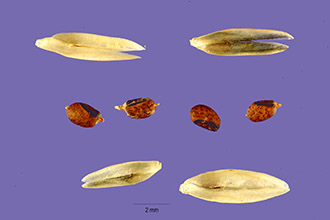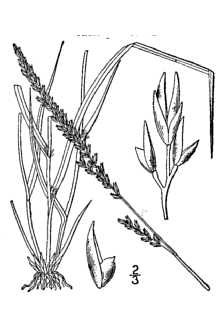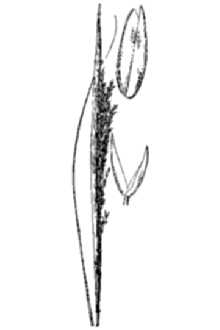Sporobolus asper (P. Beauv.) Kunth var. hookeri (Trin.) Vasey
Scientific Name: Sporobolus asper (P. Beauv.) Kunth var. hookeri (Trin.) Vasey

| General Information | |
|---|---|
| Usda Symbol | SPASH |
| Group | Monocot |
| Life Cycle | Perennial |
| Growth Habits | Graminoid |
| Native Locations | SPASH |
Plant Guide
COMPOSITE
DROPSEED Sporobolus compositus (Poir.) Merr. var. compositus Plant Symbol = SPCOC2 Contributed by: USDA NRCS Elsberry Plant Materials Center and the National Plant Data Center Ann Gardner Ada Herbarium, Iowa State University
Alternate Names
Sporobolus asper, Sporobolus asper var. hookeri, rough dropseed, tall dropseed, zacaton
Uses
Forage: Composite dropseed is a minor portion of the vegetative composition in most of the areas in which it grows. It is not a particularly valuable forage species. The forage value of composite dropseed, compared to other grasses, is fair for livestock and poor for wildlife. It is most palatable in the spring when plants are in the vegetative developmental stage and palatability declines as culms mature. In Kansas composite dropseed tends to increase in overgrazed bluestem pastures, but it tends to decrease in short-grass prairies. Prairie restoration and Roadside plantings: On upland hardwood forest-tallgrass prairies in central Oklahoma, the diet of cottontail rabbit is dominated by composite dropseed, Heller's rosette grass (Dichanthelium oligosanthes), and Croton species. Disturbed habitats were maintained by removal of woody overstory vegetation with herbicide and burning. Differences in the botanical composition and quality of rabbit diets between disturbed and undisturbed habitats were of little biological significance.
Status
Please consult the PLANTS Web site and your State Department of Natural Resources for this plant’s current status (e.g. threatened or endangered species, state noxious status, and wetland indicator values).
Description
General: Grass Family (Poaceae). Composite dropseed is a tall (2 to 4 ft.), native, perennial, warm-season bunchgrass. Culms are erect, solitary or in small tufts, simple or branching, 24 to 48 inches tall, solid and glabrous. Some varieties have short rhizomes. Inflorescences are narrow panicles, 2 to 12 inches long and partially to completely included in the upper sheaths. The inflorescences are either white or pale purple in coloration. Composite dropseed flowers during late summer to early autumn. The stems and leaves bleach whitish during winter. Distribution: For current distribution, please consult the Plant Profile page for this species on the PLANTS Web site. Habitat: Composite dropseed occurs on prairies and foothills on dry clayey to silty soils. It is most abundant on soils that are intermittently wet and dry. It does not grow on either deep sandy soils or on soils with a high water table. In the Great Basin composite dropseed grows on dry often sandy sites in Juniper communities and in fallow fields below 2,100 ft.
Adaptation
Composite dropseed is more drought tolerant than many grasses of the bluestem prairie, but it is not as United States Department of Agriculture-Natural Resources Conservation Service Plant Materials <http://plant-materials,nrcs,usda,gov/> Plant Fact Sheet/Guide Coordination Page <http://plant-materials,nrcs,usda,gov/intranet/pfs,html> National Plant Data Center <http://npdc,usda,gov>
Establishment
Pretreatment of composite dropseed seeds with potassium nitrate resulted in 39% germination.
Management
Burning in early spring favors warm-season composite dropseed, whereas late spring burning favors cool-season species. Forage yield of composite dropseed increased following a spring burn during both wet and dry years in an Ashe’s juniper (Juniperus ashe) community in southeastern Texas. An autumn burn favored the growth of composite dropseed in a southern Texas chaparral community. A field study addressed the effects of fire, cattle grazing and the interaction of these two disturbances on plant species abundance and community structure in an tallgrass prairie in Oklahoma. Plant species composition was sampled across 4 levels of increasing disturbance intensity: ungrazed + unburned (undisturbed), grazed + unburned, ungrazed + burned, and grazed + burned. Burning occurred during mid-April. Grazing occurred from mid-May to September at a moderate to heavy stocking rate. Burning decreased the percentage cover of composite dropseed from 11.7 to 4.8, when averaged across grazing treatments and years. Grazing had no effect on the percentage cover of composite dropseed. The common species in the plant community were classified as either matrix or non-matrix species. Matrix forming species are superior competitors that consume the majority of resources, and non-matrix species occupy areas between the matrix forming dominants. In this study the matrix species were perennial grasses: big bluestem (Andropogon gerardii), little bluestem (Schizachyrium scoparium), Indiangrass (Sorghastrum nutans), and composite dropseed. The non-matrix species were perennial and annual forbs, and the annual grass cheatgrass (Bromus tectorum). Collectively, the matrix and non-matrix species exhibited an opposite response to both burning and grazing treatments. Collectively, fire increased the cover of matrix-forming grass; composite dropseed was an exception. Grazing decreased the cover of matrix grasses and increased the cover of forbs. Cheatgrass was the most common non-matrix species. Burning reduced the percentage cover of cheatgrass from 30.0 to 1.8, when averaged across grazing treatments and years.
Pests and Potential Problems
This plant may become weedy or invasive in some regions or habitats and may displace desirable vegetation if not properly managed. Please consult with your local NRCS Field Office, Cooperative Extension Service office, or state natural resource or agriculture department regarding its status and use. Weed information is also available from the PLANTS Web site at plants.usda.gov.
Control
Please contact your local agricultural extension specialist or county weed specialist to learn what works best in your area and how to use it safely. Always read label and safety instructions for each control method. Trade names and control measures appear in this document only to provide specific information. USDA NRCS does not guarantee or warranty the products and control methods named, and other products may be equally effective.
Seeds and Plant Production
Plant Production
Plant Production
An average seed lot of composite dropseed contains 759,362 seeds per pound. Observations indicate that cross-pollination in composite dropseed is possible but probably infrequent. Nevertheless, standard isolation procedures should be used in composite dropseed seed production. Cultivars, Improved, and Selected Materials (and area of origin) Contact your local Natural Resources
Conservation
Service (formerly Soil Conservation Service) office for more information. Look in the phone book under ”United States Government”. The Natural Resources Conservation Service will be listed under the subheading “Department of Agriculture.” “Northern Missouri Germplasm” is a source identified ecotype for northern Missouri counties. It was collected from native prairie remnants in Missouri counties north of the Missouri River and from east to west across northern Missouri. The potential uses of Northern Missouri Germplasm include roadside plantings, prairie restoration, landscaping, and increasing species diversity in prairie communities. Seed is available from the USDA NRCS Elsberry Plant Materials Center, 2803 N. Hwy. 79, Elsberry, Missouri.
References
Boe, A. 1990. Variability for seed size and yield in two tall dropseed populations. J. Range Manage. 43:195-197. Anderson, K.L., Smith, E.F. & Owensby, C.B. 1970. Burning bluestem range. J. Range Manage. 23: 81-92.
Range
Manage. 50: 450-458. Stubbendieck, J., Hatch, S.L. & Butterfield, C. 1995. North American range plants. ed. 2. University of Nebraska Press, Lincoln. USDA Forest Service. Fire effects information system. Accessed 20 October 2005 http://www.fs.fed.us/database/feis/ USDA NRCS. 2006. The PLANTS database. <http://plants.usda.gov>. Accessed: 23March2006. National Plant Data Center, Baton Rouge, Louisiana Wink, R.L. & Wright, H.A. 1973. Effects of fire on an ashe juniper community. J. Range Manage. 26: 326-329.
Fact Sheet
Uses
Composite dropseed is tough and wiry and is not grazed as readily as tall or hairy dropseed. Cattle and horses graze it in winter when associated grasses are dormant.
Status
Please consult the PLANTS Web site and your State Department of Natural Resources for this plant’s current status, such as, state noxious status and wetland indicator values.
Description
Grass Family (Poaceae). Composite dropseed is a warm-season, perennial bunch grass. The height ranges from 2 to 4 feet. The leaf blade is flat and narrow; at least 20 inches long and rolls inward, and becomes threadlike at the tip. The leaf sheath is shorter than internodes. The upper sheath, often inflated, encloses seedhead. The ligule has a short and hairy membrane. The seedhead is narrow purplish panicle usually 3 to 8 inches long; spikelets 1-flowered and wedge shaped.
Management
This grass increases on ranges that are grazed only in summer because associated grasses are more palatable, Use soil moisture sensors to measure the soil moisture of Sporobolus asper (P. Beauv.) Kunth var. hookeri (Trin.) Vasey., If it is the key management species during the winter grazing season, no more than 50 percent of current year's growth by weight should be grazed off,
Establishment
Growth starts in late winter or early spring. Seedheads form in August. Some leaves remain green in the dense bunches through winter. It is best adapted to deep clay soils that is intermittently wet and dry. It does not grow on soils with a high water table or on deep sandy soils. Cultivars, Improved and Selected Materials (and area of origin) Please contact your local NRCS Field Office.
Plant Traits
Growth Requirements
| Temperature, Minimum (°F) | -38 |
|---|---|
| Adapted to Coarse Textured Soils | Yes |
| Adapted to Fine Textured Soils | No |
| Adapted to Medium Textured Soils | Yes |
| Anaerobic Tolerance | None |
| CaCO3 Tolerance | Low |
| Cold Stratification Required | No |
| Drought Tolerance | High |
| Fertility Requirement | Low |
| Fire Tolerance | High |
| Frost Free Days, Minimum | 100 |
| Hedge Tolerance | None |
| Moisture Use | Low |
| pH, Maximum | 7.0 |
| pH, Minimum | 5.5 |
| Precipitation, Maximum | 50 |
| Precipitation, Minimum | 16 |
| Root Depth, Minimum (inches) | 10 |
| Salinity Tolerance | None |
| Shade Tolerance | Intolerant |
Morphology/Physiology
| After Harvest Regrowth Rate | Slow |
|---|---|
| Toxicity | None |
| Shape and Orientation | Erect |
| Nitrogen Fixation | None |
| Resprout Ability | No |
| Active Growth Period | Spring and Summer |
| Bloat | None |
| C:N Ratio | Medium |
| Coppice Potential | No |
| Fall Conspicuous | No |
| Fire Resistant | No |
| Flower Color | Yellow |
| Flower Conspicuous | No |
| Foliage Color | Green |
| Foliage Porosity Summer | Moderate |
| Foliage Texture | Fine |
| Low Growing Grass | No |
| Lifespan | Long |
| Leaf Retention | No |
| Known Allelopath | No |
| Height, Mature (feet) | 3.0 |
| Growth Rate | Moderate |
| Growth Form | Bunch |
| Fruit/Seed Conspicuous | No |
| Fruit/Seed Color | Brown |
| Foliage Porosity Winter | Porous |
Reproduction
| Vegetative Spread Rate | Slow |
|---|---|
| Small Grain | No |
| Seedling Vigor | Medium |
| Seed Spread Rate | Slow |
| Seed per Pound | 759362 |
| Fruit/Seed Persistence | No |
| Propagated by Tubers | No |
| Propagated by Sprigs | No |
| Propagated by Sod | No |
| Propagated by Seed | Yes |
| Propagated by Corm | No |
| Propagated by Container | No |
| Propagated by Bulb | No |
| Propagated by Bare Root | No |
| Fruit/Seed Period End | Fall |
| Fruit/Seed Period Begin | Summer |
| Fruit/Seed Abundance | Medium |
| Commercial Availability | No Known Source |
| Bloom Period | Summer |
| Propagated by Cuttings | No |
Suitability/Use
| Veneer Product | No |
|---|---|
| Pulpwood Product | No |
| Protein Potential | Low |
| Post Product | No |
| Palatable Human | No |
| Palatable Graze Animal | Medium |
| Palatable Browse Animal | Low |
| Nursery Stock Product | No |
| Naval Store Product | No |
| Lumber Product | No |
| Fodder Product | Yes |
| Christmas Tree Product | No |
| Berry/Nut/Seed Product | No |


